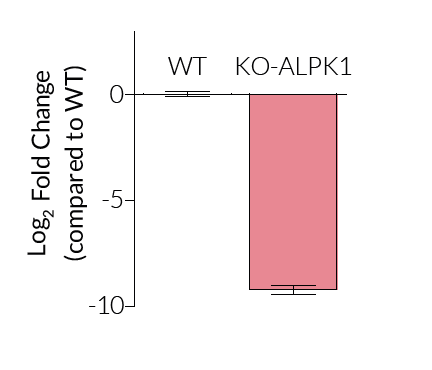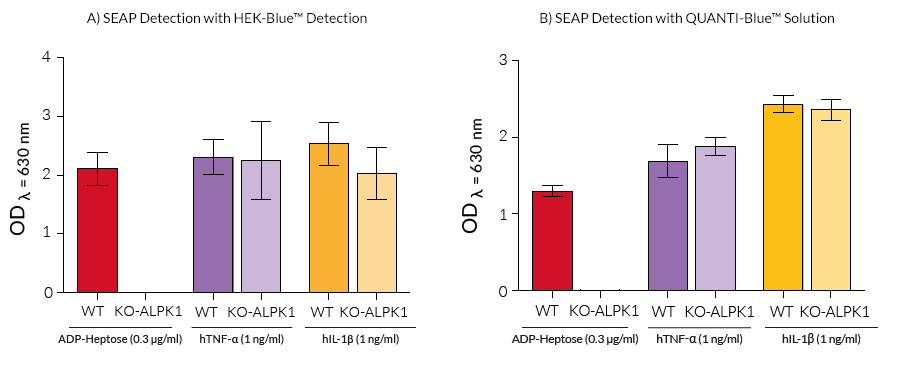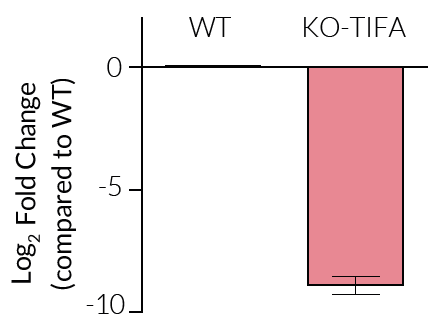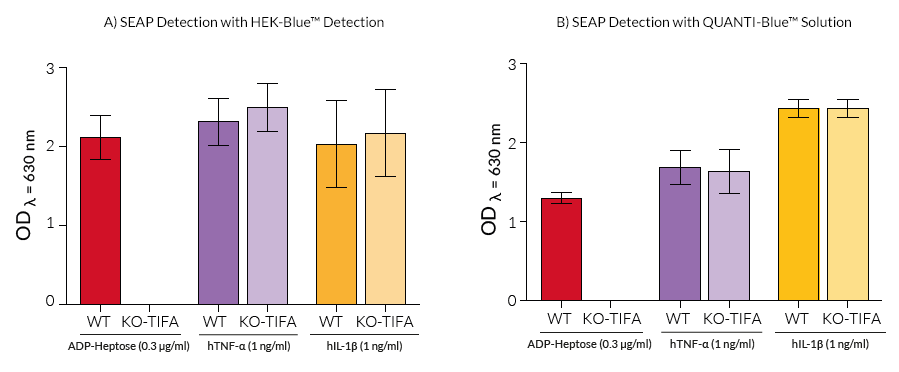KO ALPK1 & KO TIFA cells
| Product | Unit size | Cat. code | Docs. | Qty. | Price | |
|---|---|---|---|---|---|---|
|
HEK-Blue™ KO-ALPK1 Cells Knockout ALPK1 HEK 293 reporter cells |
Show product |
3-7 x 10e6 cells |
hkb-koalpk
|
|
||
|
HEK-Blue™ KO-ALPK1 vial Additional cell vial |
Show product |
3-7 x 10e6 cells |
hkb-koalpk-av
|
|||
|
HEK-Blue™ KO-TIFA Cells Knockout TIFA HEK 293 reporter cells |
Show product |
3-7 x 10e6 cells |
hkb-kotifa
|
|
||
|
HEK-Blue™ KO-TIFA vial Additional cell vial |
Show product |
3-7 x 10e6 cells |
hkb-kotifa-av
|
Notification: Reference #hkb-koalpk-av can only be ordered together with reference #hkb-koalpk.
Reference #hkb-kotifa-av can only be ordered together with reference #hkb-kotifa.
Knockout of ALPK1 or TIFA in HEK-293 cells
The ALPK1-TIFA signaling axis is an important cytoplasmic surveillance pathway of pathogenic Gram-negative bacteria. To foster research on this pathway, InvivoGen provides cellular tools that have been generated from the parental HEK-Blue™ Null1-v Cells, a human embryonic kidney (HEK)-293 derived cell line, through the stable knockout (KO) of the ALPK1 or TIFA gene. These cell lines express a secreted embryonic alkaline phosphatase (SEAP) under the control of an NF-κB-inducible promoter. Levels of SEAP in the supernatant can be easily determined with HEK-Blue™ Detection, cell culture medium for real-time detection, or QUANTI-Blue™ detection reagent (see figures).
• HEK-Blue™ KO-ALPK1 Cells - Knockout (KO) of the ALPK1 gene
• HEK-Blue™ KO-TIFA Cells – Knockout (KO) of the TIFA gene
Unlike their parental cell line HEK-Blue™ Null1-v, both HEK Blue™ KO-ALPK1 and HEK Blue™ KO-TIFA cells do not respond to cytosolic ADP-Heptose. However, they do respond to other NF‑κB inducing cytokines such as TNF-α and IL-1β.
The ALPK1-TIFA signaling axis
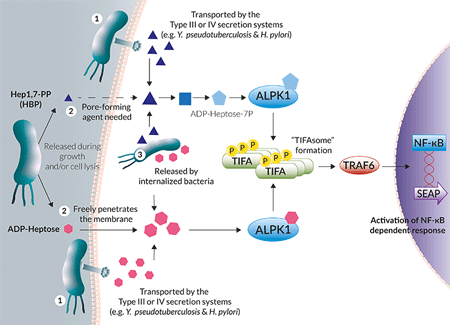
ALPK1-TIFA signaling in HEK-Blue™ Null1-v cells
Alpha protein Kinase 1 (ALPK1) and TRAF interacting forkhead-associated protein A (TIFA) form an important cytoplasmic surveillance pathway of pathogenic Gram-negative bacteria such as Shigella flexneri and Helicobacter pylori [1,2].
ALPK1 is a critical cytoplasmic alpha kinase responsible for the recognition and binding of bacterial sugar metabolites. ALPK1 recognizes and binds directly to the metabolic intermediates in lipopolysaccharide (LPS) biosynthesis, the potent ADP-β-d-manno-heptose (ADP-Heptose) and the enzymatically converted d-glycero-β-d-manno-heptose-1,7-bisphosphate (HBP) [3]. ADP-Heptose and HBP can be delivered to the host cell cytoplasm in a number of different ways including type III and IV secretion systems (e.g. Yersinia pseudotuberculosis and H. pylori, respectively), as well as by endocytosed bacteria [2-3]. Notably, ADP-Heptose can freely penetrate the cell membrane, whereas HBP requires the use of pore-forming agents [3, 4].
Activated ALPK1 phosphorylates TRAF interacting forkhead-associated protein A (TIFA), inducing its oligomerization and the formation of 'TIFAsomes', which in turn recruits and activates TRAF6. Ultimately, the ALPK1-TIFA signaling axis results in the initiation of an NF-κB dependent pro-inflammatory response [1-4].
Targeting this pathway will be important in the development of novel treatments for modulating inflammation caused by bacterial infection as well as diseases associated with its dysregulation such as gastric cancer.
Features of HEK-Blue™ KO-ALPK1 and KO-TIFA Cells:
- Verified KO of the ALPK1 or TIFA gene (DNA sequencing, PCR, and functional assays)
- Complete abrogation of the response to the LPS-intermediary metabolite ADP-Heptose
- Readily assessable NF-κB-dependent SEAP reporter activity
Features of HEK-Blue™ Null1-v Cells:
- Fully functional ALPK1-TIFA signaling pathway
- Responds to the LPS-intermediary metabolite ADP-Heptose
- Readily assessable NF-κB-dependent SEAP reporter activity
References:
1. Garcia-Weber, D. et al. 2018. ADP-heptose is a newly identified pathogen-associated molecular pattern of Shigella flexneri. EMBO Rep 19
2. Zimmermann, S. et al. 2017. ALPK1- and TIFA-Dependent Innate Immune Response Triggered by the Helicobacter pylori Type IV Secretion System. Cell Rep 20, 2384-2395.
3. Zhou, P. et al. 2018. Alpha-kinase 1 is a cytosolic innate immune receptor for bacterial ADP-heptose. Nature 561, 122-126.
4. Pfannkuch, L. et al. 2019. ADP heptose, a novel pathogen-associated molecular pattern identified in Helicobacter pylori. FASEB J, fj201802555R.
Specifications
HEK-Blue™ KO-ALPK1/ HEK-Blue™ KO-TIFA/ HEK-Blue™ Null1-v Cells
Growth medium: DMEM, 4.5 g/L glucose, 2 mM L-glutamine, 10% (v/v) heat-inactivated fetal bovine serum (FBS), 100 U/ml penicillin, 100 µg/ml streptomycin, 100 µg/ml Normocin™
Antibiotic resistance: Zeocin®
Quality Control for all cell lines:
- The stability for 20 passages, following thawing, has been verified.
- These cells are guaranteed mycoplasma-free.
Quality Control for HEK-Blue™ KO-ALPK1 cells only:
- ALPK1 gene knockout has been verified by DNA sequencing, PCR, and functional assays.
Quality Control for HEK-Blue™ KO-TIFA cells only:
- TIFA gene knockout has been verified by DNA sequencing, PCR, and functional assays.
Quality Control for HEK-Blue™ Null1-v cells only:
- Activation of the NF-κB response has been verified upon stimulation with various inducers (e.g. TNF-α, IL-1β, and ADP-Heptose).
Contents
HEK-Blue™ KO-ALPK1/ HEK-Blue™ KO-TIFA/ HEK-Blue™ Null1-v Cells
Please note: Each cell line is sold separately. See TDS for the exact contents of each cell line.
- 3-7 x 106 HEK-Blue™ KO-ALPK1 or HEK-Blue™ KO-TIFA or HEK-Blue™ Null1-v cells in a cryovial or shipping flask
- 1 ml of Zeocin® (100 mg/ml)
- 1 ml of Normocin™ (50 mg/ml). Normocin™ is a formulation of three antibiotics active against mycoplasmas, bacteria, and fungi.
- 1 pouch of HEK-Blue™ Detection (cell culture medium for real-time detection of SEAP)
![]() Shipped on dry ice (Europe, USA, Canada and some areas in Asia)
Shipped on dry ice (Europe, USA, Canada and some areas in Asia)
Back to the top






